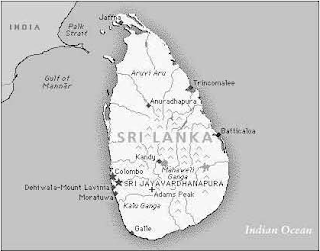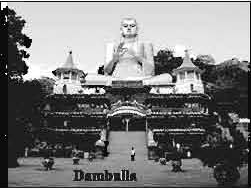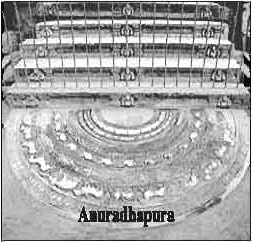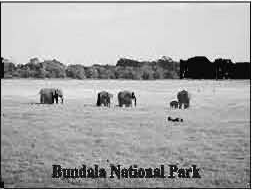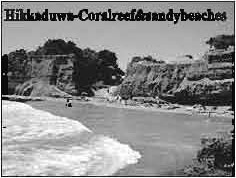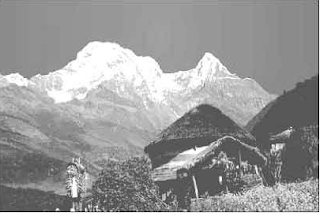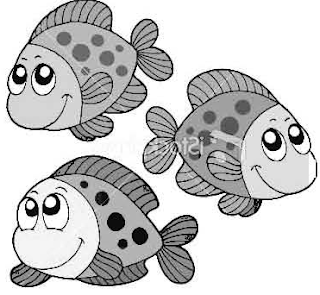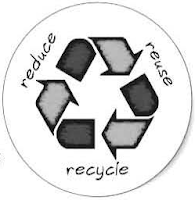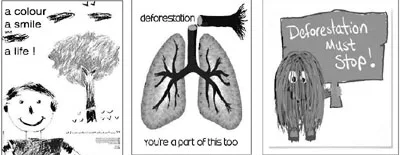A. Discuss these questions in pairs.
1. Which country is often known as the Pearl of the Indian Ocean?
2. Which country is the world's largest tea exporter?
3. Which country did the spice cinnamon originate from?
4. Which country was mentioned in the great Indian epic the Ramayana!
5. Which country has the highest literacy rate in South Asia?
B. Now read the following passage to find your answers to the questions in A
a. Anyone visiting Sri Lanka may often hear the word Ayubowan. This word means 'May you have the gift of long life'. It is with this traditional greeting that everyone is welcomed to Sri Lanka. Sri Lanka is variously known as: Serendip, Ceylon, Teardrop of India, Pearl of the Indian Ocean, etc. These names reveal the richness and beauty of this island nation. Many travellers, from ancient mariners and merchants to present day tourists, have been attracted by the beauty of this island.
b. Sri Lanka is located in the Indian Ocean, just off the south-eastern coast of India. Shaped like a teardrop, the island of Sri Lanka measures about 415 kilometers from north to south, and about 220 kilometers from east to west, with a total land area of about 65,600 square kilometers. It has more than 1340 kilometers of coastline.
c. Despite its modest size Sri Lanka has a population of about 20 million. Sri Lanka is a multi- religious, multi-racial and multi-
lingual country. The four major ethnic groups are the Sinhalese, Sri Lankan Tamils, Indian Tamils and Sri Lankan Moors or Muslims. A fifth group, the Veddhas are the original inhabitants of the island. The ancient history of Sri Lanka is depicted in the Hindu epic the Ramayana. But die most important work on Lankan origin is related Colombo; The capital city in Mahavamsa or 'The Great Chronicle'.
d. Sri Lanka's economy has traditionally been based on agriculture. The emphasis is on exporting crops such as tea, rubber, and coconuts. In feet, Sri Lanka is the largest tea exporter of the world. The country is also a major producer and supplier of a variety of spices such as cinnamon, cardamom, pepper, cloves, and nutmeg. Cinnamon first originated in Sri Lanka and was introduced later to the world by the Arab merchants.
e. Sri Lanka's archaeological treasures may be compared to other civilizations of the past like the Golden Age of Greece, the Roman Empire and Mayan citadels. The culture that followed those glorious pasts has been enriched by the more recent influences of Western colonizers and Eastern traders. That resulted in developing a unique mix of races and religions, arts and crafts, festivals and costumes in this small country.
Besides the man-made riches, one may find the God-given blessings of nature in Sri Lanka. The island is circled by azure seas and is blessed with sandy beaches, green hills, cascading waterfalls, abundant wildlife and a variety of flowers and fruits. The country abounds with coconut groves, spice gardens, tea estates and many other gardens and woods. Travellers from all over the world come to Sri Lanka. Here, a weary traveller can pass a relaxing day by a palm-shaded lagoon looking at the endless ocean. And for the adventurous, days can be full of excitement snorkelling, swimming, fishing or sailing.
C. From your reading of the above text complete the table with no more than two words and/or numbers.
1. Which country is often known as the Pearl of the Indian Ocean?
2. Which country is the world's largest tea exporter?
3. Which country did the spice cinnamon originate from?
4. Which country was mentioned in the great Indian epic the Ramayana!
5. Which country has the highest literacy rate in South Asia?
B. Now read the following passage to find your answers to the questions in A
a. Anyone visiting Sri Lanka may often hear the word Ayubowan. This word means 'May you have the gift of long life'. It is with this traditional greeting that everyone is welcomed to Sri Lanka. Sri Lanka is variously known as: Serendip, Ceylon, Teardrop of India, Pearl of the Indian Ocean, etc. These names reveal the richness and beauty of this island nation. Many travellers, from ancient mariners and merchants to present day tourists, have been attracted by the beauty of this island.
b. Sri Lanka is located in the Indian Ocean, just off the south-eastern coast of India. Shaped like a teardrop, the island of Sri Lanka measures about 415 kilometers from north to south, and about 220 kilometers from east to west, with a total land area of about 65,600 square kilometers. It has more than 1340 kilometers of coastline.
c. Despite its modest size Sri Lanka has a population of about 20 million. Sri Lanka is a multi- religious, multi-racial and multi-
lingual country. The four major ethnic groups are the Sinhalese, Sri Lankan Tamils, Indian Tamils and Sri Lankan Moors or Muslims. A fifth group, the Veddhas are the original inhabitants of the island. The ancient history of Sri Lanka is depicted in the Hindu epic the Ramayana. But die most important work on Lankan origin is related Colombo; The capital city in Mahavamsa or 'The Great Chronicle'.
d. Sri Lanka's economy has traditionally been based on agriculture. The emphasis is on exporting crops such as tea, rubber, and coconuts. In feet, Sri Lanka is the largest tea exporter of the world. The country is also a major producer and supplier of a variety of spices such as cinnamon, cardamom, pepper, cloves, and nutmeg. Cinnamon first originated in Sri Lanka and was introduced later to the world by the Arab merchants.
e. Sri Lanka's archaeological treasures may be compared to other civilizations of the past like the Golden Age of Greece, the Roman Empire and Mayan citadels. The culture that followed those glorious pasts has been enriched by the more recent influences of Western colonizers and Eastern traders. That resulted in developing a unique mix of races and religions, arts and crafts, festivals and costumes in this small country.
Besides the man-made riches, one may find the God-given blessings of nature in Sri Lanka. The island is circled by azure seas and is blessed with sandy beaches, green hills, cascading waterfalls, abundant wildlife and a variety of flowers and fruits. The country abounds with coconut groves, spice gardens, tea estates and many other gardens and woods. Travellers from all over the world come to Sri Lanka. Here, a weary traveller can pass a relaxing day by a palm-shaded lagoon looking at the endless ocean. And for the adventurous, days can be full of excitement snorkelling, swimming, fishing or sailing.
C. From your reading of the above text complete the table with no more than two words and/or numbers.
Sri Lanka: Facts
|
||
People
|
Economy
|
Natural beauty
|
There are………., four main ethnic groups. They are
Sinhalese, Sri Lankan
Tamils,..........................
and Sri Lankan Moors who are
also known as
........................ The
earliest residents of Sri
Lanka are known as
|
Agriculture is a traditional
form of economic activity in Sri Lanka. The country exports many
crops and.........................
Sri Lanka tops the world in
tea export. The spice
.......................... was
found first in Sri Lanka.
|
Sri Lanka is blessed with awesome natural beauty.
There are blue seas, sandy beaches, green hills, and flowing………. The country
has a very rich wild life. A wide variety of fruits and……are also
available there. Traveler can
enjoy the……….view sitting by the palm shaded lagoons.
|
D. The passage in B has six paragraphs (a-f). Choose the most suitable headings for paragraphs (a-f) from the list of headings below. There are more headings in the box than the paragraphs, so you will not use all of them.
List of headings
1. A beautiful island with natural richness
2. Teardrop of India
3. Geographical features
4. A rich multicultural setting
5. Some religious groups of Sri Lanka
6. A traditional economy
7. The land of cinnamon
8. A melting pot of the past civilizations
9. Tourist attractions and leisure activities
10. A country with beautiful beaches
E. Read the brief descriptions of some of the best tourist places in Sri Lanka. Then discuss the questions that follow.
Anuradhapura
Anuradhapura is one of the ancient capitals of Sri Lanka. The old city is today surrounded by monasteries, covering an area of over sixteen square miles. The city is also significant in Hindu legend as the capital of King Ravana.
Bundala National Park
Bundala National Park is one of Sri Lanka's leading destinations for birdwatchers. The park is also home to large populations of elephants, crocodiles, turtles and leopards.
Hikkaduwa-Coral reef & sandy beaches
Hikkaduwa is a little town on the south coast of Sri Lanka. It is well-known for its beach and corals. It is principally a tourist destination, and serves as a great beach with options to surf, snorkel and enjoy the sun.
Dambulla
Major attractions of this city include the biggest and greatest potted cave temple complex of Sri Lanka. It is also famous for the Rangiri Dambulla Global Stadium, which was built in just 167 days. The city also boasts of the biggest rose quartz mountain range in South Asia and the iron wood forest.
Now discuss the following questions in pairs.
1. Which of the following tourist places do you like to visit?
• Places with beaches
• Places of historical importance
• Places that preserve wildlife Explain why you like such a place.
2. If you are given an offer to visit any two of the four Sri Lankan cities above, which two cities will you choose. Explain why.
F. Write a paragraph on some of the interesting places to visit in Sri Lanka. Use your own words and the information given in section E.
If you want to read the next lesson of this unit please click the link below:

